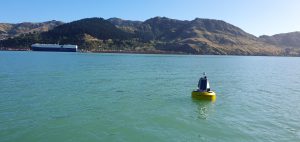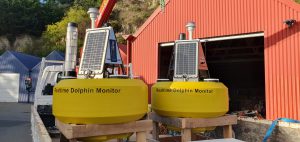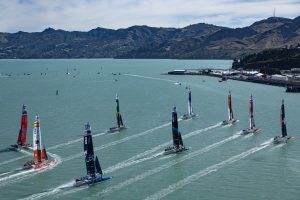
LPC operates within an ecologically sensitive environment. LPC is committed to protecting and improving the health of Whakaraupō/Lyttelton Harbour while meeting the shipping needs of the region’s economy and community.
Recently, LPC wrapped up a five-year programme to monitor Hector’s dolphins during two major construction projects, including the new cruise berth and channel deepening.
This programme involved acoustic and visual monitoring to understand dolphin presence and to assess Hector’s dolphin’s behavioural responses to piling and dredging activities.
Developing a world-leading acoustic data set
Over the five years of the programme, more than 100,000 hours of underwater acoustic information were recorded. This included raw audio data collected by four Soundtrap hydrophones (underwater microphones) with a sample rate of 288,000 samples per second.

This data set was fed into a deep learning system (type of AI) to develop a computer model that accurately detected Hector’s dolphins.
An acoustic data set with trillions of raw data points is a pot of gold for acoustic researchers. The same audio can be reprocessed in countless ways to provide information about the underwater environment.
Dr Matt Pine, Principal Scientist of Underwater Acoustics at Styles Group, explains. “All this data has enabled us to create a detection model that is incredibly effective at picking out Hector’s dolphins.”
Ironically, humans can’t hear the clicks made by Hector’s dolphins. That’s because the frequency of their clicks is about six times higher than the pitch our ears can listen to.
Like those used in the LPC study, hydrophones allow scientists to visualise the sounds people can’t hear. They let us see the oceans the way marine mammals see the oceans.
Applications of the model
In March 2023, SailGP was hosted in Whakaraupō/Lyttelton Harbour. The dolphin detection model, developed from LPC’s data set, was used to detect any dolphins on the course during the event.
Matt describes the detection process for SailGP.
“We put the computer model into buoys on the course. Whenever a dolphin was detected, the computer program would ping, and eight seconds later, I would get a text alert.”
“It was essential to get accurate information. If animals were there, we needed to know for their safety. At the same time, a false positive would have had negative consequences.”

Other ports and marinas around New Zealand also use the model, including Port Marlborough as part of the Waitohi Picton Ferry Precinct Redevelopment. Like LPC, marine mammal exclusion zones will be implemented to protect the safety of any animals entering the construction area.
All acoustic data from LPC’s programme has fed into the detection model used to detect Hector’s dolphins on the project, while additional species are also being monitored around Picton.
“Acoustic monitoring is an excellent tool for monitoring exclusion zones because acoustic detection ranges are far greater than people can see, especially in bad weather,” said Matt.
The value of accurate information
“The length and depth of the LPC acoustic monitoring programme have set the bar very high, and that’s a good thing. Not only does it ensure better protection for marine mammals, but it also benefits decision-makers.”
The value of LPC’s work extends beyond New Zealand shores. Once the data are published in an open-source journal later this year, researchers worldwide will be able to access the information for their work.
Matt explains from a scientist’s point of view. “Researchers are usually on the outskirts of the process, collecting data opportunistically or from a distance. In LPC’s programme, scientists had unfettered access to information, acoustic and visual. On a world stage, that’s special.”
Trillions of data points, unlimited potential
For the Ports of the world, progress is inevitable. Ships are getting bigger, tourism is growing, and development will be necessary to accommodate future needs. But with programmes like the LPC acoustic research study, ports can find better ways to undertake development and safeguard marine mammal species and the places they call home at the same time.
“The follow-on benefits of this programme are immense. Providing an extra layer of protection for dolphins during an event like SailGP was absolutely needed – and only possible with LPC’s dataset”, concludes Matt.
“LPC has been the first to recognise the need to protect marine mammals and commit to research. Their level of commitment has set the bar very high.”